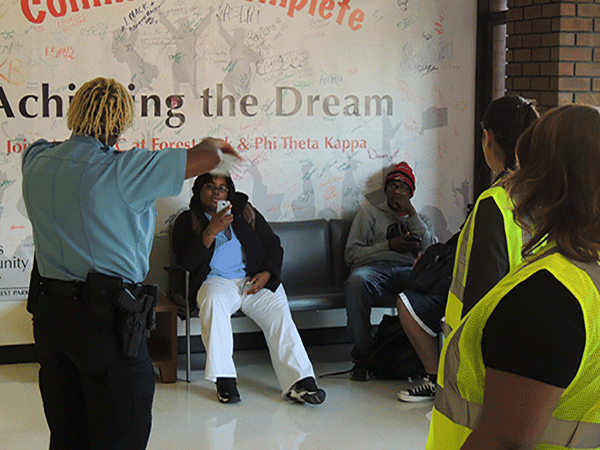
By Brian Ruth
The Scene staff
The armed-intruder drill that locked down the Forest Park campus on Oct. 22 was over in 20 minutes and was deemed a success by college officials.
Students, faculty and staff were instructed to stay in their rooms, lock the doors, turn off the lights and get out of sight. Those caught outside were “rounded up” and told to stay put.
“Students that are out in the hallway (during a real incident), call them ‘victims,’ because that’s what they are,” said Forest Park Police Chief Richard Banahan. “That’s why they need to hide, by taking cover.”
The drill allowed Forest Park to practice procedures that will be put in place if a real armed intruder poses a threat on campus. Students received an email notice the day before.
After a briefing with security personnel, Interim President Roderick Nunn announced the start of the drill. Within two minutes, the C-circle hairpin was closed.
A police officer riding a Segway began rounding up stray students and giving instructions. Students in the courtyard were told to stay in a group until getting the “all-clear” signal.
Officer Tracy Buford and Nunn rushed from the Student Center to make sure the library doors were locked. Then they joined City of St. Louis Public Safety Coordinator Sarah Gamblin-Luig.
Physical Education Associate Professor Mark Applegate and Hospitality Studies Program Coordinator Craig Mueller coordinated the “floor captains” (staff and faculty on the response team).
“I don’t expect students to know exactly what to do during these things,” Banahan said. “But I do expect the faculty and staff to take this seriously.”
This is the third year for armed-intruder planning at Forest Park. In the spring, the stakes get higher because the drill will not be announced in advance.
“No matter what the incident may be, that muscle memory is going to kick in and we’re going to know what to do,” Buford said. “That’s why we train.”
The recent drill started at 10 a.m. on a Wednesday morning. By 10:17, the response team had returned to a Student Center meeting room for debriefing – known as the “hot wash” – by campus police.
“The hot wash identifies what we excel at and identifies the gaps,” said Tony Russo, police chief at the Meramec campus, who participated in the Forest Park drill.
Nunn wanted to see more verbal instructions from police officers as they patrolled campus. But Banahan noted that floor captains will be the ones in close contact with students.
The most-discussed problem was a premature tweet sent from the college’s Twitter account, announcing the drill would take place three hours too early. It was later corrected.
“We’ve had similar issues with communication during drills at City Hall, but Forest Park is better positioned for a real situation,” Gamblin-Luig said.
Only two incidents of student non-compliance were reported at the debriefing. Banahan said compliance on the “serious stuff” was about 90 percent.
“The majority (of students, faculty and staff) did exactly what we needed them to do,” he said. “We found things that we did wrong, but we know how to improve them.”
